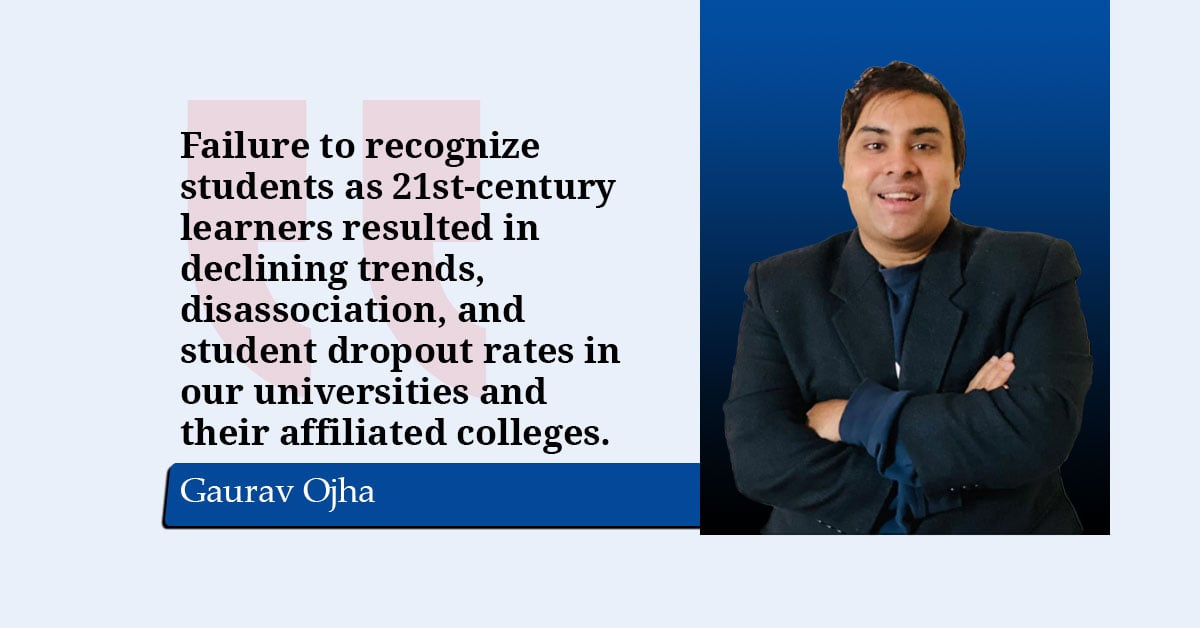

KATHMANDU: Unlike commercial banks that rigorously apply the “Know Your Customer” (KYC) policy, Nepalese universities during the first two decades of the 21st century utterly failed to recognize the shifting aspirations, expectations, and inspirations of their students.
Universities in Nepal kept on dragging themselves with assumptions and pretexts of the 20th-century higher education model, such as prioritized standardized testing, a teacher-centered approach, passive learning, textbooks, lectures, and academic accomplishments from the students based on the prescribed curriculum, which does not align well with the needs and expectations of students as 21st-century learners. Hence, this failure to recognize students as 21st-century learners resulted in declining trends, disassociation, and student dropout rates in our universities and their affiliated colleges.
Emergence of 21st-Century Learners
The 21st century has brought about significant changes in the scope, significance, and purpose of higher education. One of the most important shifts in higher education is the move towards skills rather than content knowledge.
The World Economic Forum has also identified a critical need for students to graduate with critical thinking, self-leadership, problem-solving, creativity, communication, teamwork, digital, and adaptability skills because the professional and workplace characteristics of the 21st century demand applicable skills more than just the ability to recall information.
Different from students of previous generations, the 21st-century learners look for a different set of aspirations, balances, and expectations from Nepalese higher education. These learners are independent, outcome-focused, career-oriented, market-savvy, tech-friendly, and economically concerned.
Rather than rigid lecture-based formats and course content teaching, they want higher education with flexibility, professionalism, that balances between learning and doing, skill development, and infrastructure/facilities with international standards.
Similarly, 21st-century learners are digital natives pretty much unfamiliar with life without internet, cell phones, and computers. Hence, they prefer technologically-enhanced learning environments, which includes blended learning models, utmost use of research and educational software and a course content design that assimilates digital platforms into its pedagogical practices.
Moreover, in this age of global awareness, students in Nepal have become aware of alternative pathways, emerging trends and various modalities of courses for university level education available in the international market.
There is also a growing preference among 21st-century learners for flexible schedules, dual degrees, and short-term practical courses that provide industry-ready expertise, as all career pathways do not require a full degree. However, even in this age of digital dynamism and knowledge economy, transformation has been a rather slow and sluggish process in the Nepalese higher education system due to the ‘business as usual’ mindset.
Graduate studies can’t remain as an extension of high school education
As the quality of high school-level education improved with Plus-Two and A-Level colleges in terms of technology, extra-curricular activities, college events, industrial tours, classroom presentations and skill- and project-based learning, many high school graduates started to perceive university education in Nepal as just a continuation of their school-level experience.
Similarly, it was gross negligence on the part of some Nepali universities to allow affiliated colleges to use the same infrastructure and facilities for both high school-level and graduate/postgraduate classes.
More importantly, when high school graduates were looking for something interactive, professional, technologically supported, market relevant, skill-based, and practical, our universities continued on with their existing protocols of lecture hours, mandatory classroom attendance, educators as authoritative figures, prescribed methods, fixed evaluation formats, loads of theories and concepts, uncomfortable classroom setups and a grading system based on written exams.
Moreover, as Nepali students got exposure to foreign universities and their images of sophisticated infrastructure, advanced lab facilities, tech-integrated course design, knowledge experts as faculty members, the attraction towards foreign universities turned into a fixation.
Ironically, most of the Nepalese universities and their affiliated colleges are still obsessed with grades, class toppers, dean’s listers, and hanging photos of few graduates who have passed public service exams after taking classes in coaching centers. Hence, universities in Nepal have failed to resonate with students as 21st century learners who are looking for holistic and practical based higher education experiences that an emphasis on developing communication, leadership, problem-solving, and research skills.
The Need for New Mindset
The 21st-century learners are defined by their concern for acquiring a set of skills, and these skills are categorized as learning skills (the four C’s: critical thinking, creativity, collaboration, and communication), literacy skills (IMT: information, media, and technology literacy), and life skills (FLIPS: flexibility, leadership, initiative, productivity, and social skills).
However, universities in Nepal and institutions of higher education (HEIs), with their infrastructure, facilities, faculties, course designs, and education practices, have largely failed to convince a significant portion of students that they are relevant, reliable, and effective platforms to develop these skills.
In order to persuade students in the twenty-first century that they are in tune with local and global realities that go beyond theories, concepts, and academic knowledge, faculty members must also change from being merely information distributors to learning facilitators, subject matter experts, innovators, applied researchers, socially engaged intellectuals and industry partners.
Similarly, Nepali universities and their affiliated institutions need to apply effective digital marketing strategies, collaborate with online influencers, and create engaging social media content in order to appeal to digital natives.
Moreover, to effectively serve 21st-century learners, Nepali universities need a new mindset, a bit more agility and dynamismthat embraces emerging market undercurrents, out-of-the-box thinking in course design, focus on professional skills development, investment in high-tech integration, interactions sessions with professional and entrepreneurs, organize seminars, business competitions and prioritize learner-centric approach.
More significantly, higher education institutions in Nepal must realize that their “business as usual” mentality is no longer viable to attract, retain, and remain relevant to students in the twenty-first century.
(Gaurav Ojha is a writer, researcher, and educator at different educational institutions)